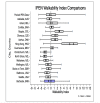Neighbourhood Walkability and Its Influence on Physical Activity and Cardiometabolic Disease: A Cross-Sectional Study in a Caribbean Small Island Developing State
- PMID: 37746352
- PMCID: PMC10517735
- DOI: 10.7759/cureus.44060
Neighbourhood Walkability and Its Influence on Physical Activity and Cardiometabolic Disease: A Cross-Sectional Study in a Caribbean Small Island Developing State
Abstract
Introduction Cities and neighborhoods may provide opportunities for population-level environmental interventions to reduce physical inactivity and cardiometabolic risk. In this study, we describe the association between neighborhood walkability, physical activity (PA), and cardiometabolic outcomes, by linking data from a nationally representative survey of adults (25 years and older) collected in 2012-2013 with spatial data on built environment features in Barbados. Methods We estimated a walkability index for 45 neighborhoods using objectively measured built environment features (residential density, street connectivity, and land use mix). We used the Recent Physical Activity Questionnaire to capture time spent in outdoor walking, active commuting, moderate-to-vigorous PA (MVPA), and total PA. Our primary cardiometabolic outcome was a predicted 10-year cardiovascular risk (CVD) score, estimated using the American College of Cardiology/American Heart Association pooled cohort equation. Our secondary cardiometabolic outcomes were hypertension and diabetes. We explored the effect of neighborhood walkability on PA and cardiometabolic outcomes using several multivariable regression models (tobit and linear and logistic multi-level mixed effects), with the model choice depending on the structure of the outcome. Results The average time spent walking weekly for any purpose among participants was 75 minutes/week, time spent on active commuting was 15 minutes/week, and MVPA was 221 minutes/week. We estimated that the average 10-year CVD risk in the study population was 11.7% (95%CI 10.9-12.5). Our confounder-adjusted analyses showed positive linear relationships between neighborhood walkability and each PA outcome (p<0.05 in all cases), and a negative relationship between walkability and predicted 10-year CVD risk (p<0.001). Conclusion In our setting, adults residing in higher walkability neighborhoods spent more time engaged in PA, had a lower predicted 10-year CVD risk, and were less likely to have diabetes. Urban planners may consider shorter-term interventions, such as those on a microscale, which may provide additional ways to increase activity in a mostly fixed macroscale environment.
Keywords: 10-year cardiovascular risk; built environment; cardiovascular disease; caribbean; health of the nation survey; physical activity; recent physical activity questionnaire; small island developing states; urban planning.
Copyright © 2023, Rocke et al.
Conflict of interest statement
The authors have declared financial relationships, which are detailed in the next section.
Figures



Similar articles
-
Does time spent in the residential neighbourhood moderate the relationship between neighbourhood walkability and transport-related walking? a cross-sectional study from Toronto, Canada.BMJ Open. 2019 Apr 3;9(4):e023598. doi: 10.1136/bmjopen-2018-023598. BMJ Open. 2019. PMID: 30948565 Free PMC article.
-
Neighborhood Built Environment and Socioeconomic Status are Associated with Active Commuting and Sedentary Behavior, but not with Leisure-Time Physical Activity, in University Students.Int J Environ Res Public Health. 2019 Aug 31;16(17):3176. doi: 10.3390/ijerph16173176. Int J Environ Res Public Health. 2019. PMID: 31480418 Free PMC article.
-
Relationship between neighborhood walkability and older adults' physical activity: results from the Belgian Environmental Physical Activity Study in Seniors (BEPAS Seniors).Int J Behav Nutr Phys Act. 2014 Aug 23;11:110. doi: 10.1186/s12966-014-0110-3. Int J Behav Nutr Phys Act. 2014. PMID: 25148845 Free PMC article.
-
Neighborhood built environment and socio-economic status in relation to multiple health outcomes in adolescents.Prev Med. 2017 Dec;105:88-94. doi: 10.1016/j.ypmed.2017.08.026. Epub 2017 Aug 31. Prev Med. 2017. PMID: 28863871
-
Understanding the relationship between built environment features and physical activity in the Caribbean: A scoping review.Dialogues Health. 2022 Dec 5;2:100088. doi: 10.1016/j.dialog.2022.100088. eCollection 2023 Dec. Dialogues Health. 2022. PMID: 38515496 Free PMC article.
Cited by
-
Neighborhood walkability and cardiometabolic disease in Texas.Sci Rep. 2025 Mar 19;15(1):9488. doi: 10.1038/s41598-025-94192-x. Sci Rep. 2025. PMID: 40108373 Free PMC article.
References
-
- The global burden of cardiovascular diseases and risk factors: 2020 and beyond. Mensah GA, Roth GA, Fuster V. J Am Coll Cardiol. 2019;74:2529–2532. - PubMed
-
- The global burden of cardiovascular diseases and risks: a compass for global action. Roth GA, Mensah GA, Fuster V. J Am Coll Cardiol. 2020;76:2980–2981. - PubMed
Grants and funding
LinkOut - more resources
Full Text Sources
